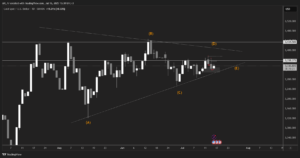The European Union reached a ground-breaking agreement late on Monday to ban 90% of Russian crude oil by the end of the year along with an instant ban on two-thirds of such imports. According to a statement from the European Council, “The European Council agrees that the sixth package of sanctions against Russia will cover crude oil, as well as petroleum products, delivered from Russia into Member States, with a temporary exception for crude oil delivered by pipeline.” This embargo from the 27-country bloc is the latest one in a series of punitive measures against Russia, with the intention to make Moscow economically weaker, as punishment for the country’s military invasion of Ukraine. According to German Chancellor Olaf Scholz, “The sanctions have one clear aim: to prompt Russia to end this war and withdraw its troops and to agree with Ukraine on a sensible and fair peace.”
Russia was Europe’s main energy market, with approximately half of the country’s oil exports going to the EU. It is, thus, believed that the union’s decision last Monday is one that Russia will, inevitably, feel heavy at its core. As Ukrainian Minister of Foreign Affairs, Dmytro Kuleba, argues “The oil embargo will speed up the countdown to the collapse of the Russian economy and war machine.” However, the decision was met with some decisions from analysts. Matteo Villa, an analyst at the Institute for International Political Studies (ISPI) in Italy, argued that whilst Russia will suffer the blow now, he also added that the move could eventually backfire, noting “The risk is that the price of oil in general goes up because of the European sanctions. And if the price goes up a lot, the risk is that Russia starts to earn more, and Europe loses the bet.”
The ban, albeit targeting Russia, also translates to certain countries feeling first-hand the effects of the upcoming oil embargo. The European Council stated in their announcement on Monday that where any “sudden interruptions” of supply take place, “emergency measures” will be introduced to ensure security of supply. Inevitably, Europe, the United States, and many other countries around the world will also suffer from increased oil prices, even as the oil prices have been considerably higher for months. Specifically, at present, oil prices have been trading at highs last seen more than thirteen years ago. Europe’s Brent crude oil, the US WTI crude oil, and OPEC’s basket are important determinants for traders when referencing oil and gasoline prices. On May 31, 2022, the Brent crude oil price stood at $115.6 per barrel; just five months prior, the price per barrel stood at a low price of $78.6, whereas a year ago, the price was at $70.25 per barrel. Similar increases have been documented for US WTI crude oil and OPEC’s basket as well.
Despite news of the embargo affecting almost the entire world, China and India appear unscathed from all the latest developments as they obtain even more bargaining power. Chris Weafer, CEO at consulting firm Macro-Advisory said that “India has been a willing buyer” and “China’s certainly been keen to buy more oil because they’re both countries who are getting big discounts on global market prices… Now, for the moment, that’s not financially too painful for Russia because global prices are elevated. They’re much higher than last year,”, adding that “So even Russia offering a discount means that it’s probably selling its oil for roughly what it sold for last year also.” It remains to be seen how Russia will respond to the latest round of sanctions. One thing is for sure; for a country that has previously withheld energy to get its way, the embargo is unlikely to persuade the Kremlin to retreat and end the war.
Disclaimer: This article is not investment advice or an investment recommendation and should not be considered as such. The information above is not an invitation to trade and it does not guarantee or predict future performance. The investor is solely responsible for the risk of their decisions. The analysis and commentary presented do not include any consideration of your personal investment objectives, financial circumstances, or needs.





